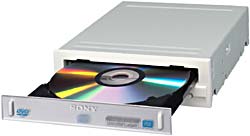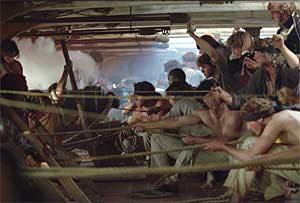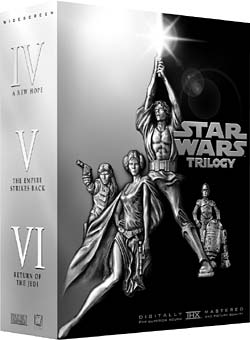Home Entertainment Blog Archive
Brought to you by your friendly, opinionated, Home Entertainment and Technology writer, Stephen DawsonHere I report, discuss, whinge or argue on matters related to high fidelity, home entertainment equipment and the discs and signals that feed them. Since this Blog is hand-coded (I like TextPad), there are no comments facilities. But feel free to email me at scdawson [at] hifi-writer.com. I will try to respond, either personally or by posting here emails I consider of interest. I shall assume that emails sent to me here can be freely posted by me unless you state otherwise.
This archive is for an uncertain period commencing Thursday, 25 March 2004
A weak point of Australian free to air TV has been a near complete lack of Electronic Program Guides (EPG). Europe has these, accessible via Teletext, which makes setting up recordings on an appropriately equipped DVD recorder very simple, since you can select the program you want to record by name. Some even recognise coding embedded in the signal and adjust the recording for delayed starts and finishes.
But here, all we have is manual entry of recording times taken from a TV program (or the G-Code system which just reduces the number of keystrokes). Experienced TV recordists know that it's wise to set the recording to start at least five minutes early, and finish 15 minutes after the scheduled end time, just to allow for problems with the broadcast.
Digital TV may offer better solutions in the future. Currently a trial is underway in Sydney of a datacasting service that includes all free-to-air stations' programs. Maybe that can be leveraged one day into convenient recording services. For now, though, there's no help on this front. Here in Canberra only two of the stations offer any programming information within their data streams, and these are only 'now' and 'next'.
In the meantime, my brother has drawn my attention to a Web-based TV guide for Australian TV programming. No, it doesn't offer any automation, but it still releases us from reliance on printed guides. And offers hope that maybe one day there will be some linkage for automated recording. As it stands, though, it is very useful with good information on the TV programs. It seems to cover everywhere in Australia, plus the various Pay TV channels. Check out the Australian TV Guide.
The company behind this is something called HWW Limited, which provides data syndication services. Amongst its offerings are 'TV Metadata Services'. It doesn't say precisely what these are, but it smacks of such things as EPGs and program information. I shall be watching this with interest.
 I had a long lunch yesterday with Gordon Kerr,
Sony Australia's Group Sales and Marketing Manager for Recording Media, Energy and Optical. The main focus was on the new dual layer DVD recording format, but our discussions turned out to be fairly broad ranging.
I had a long lunch yesterday with Gordon Kerr,
Sony Australia's Group Sales and Marketing Manager for Recording Media, Energy and Optical. The main focus was on the new dual layer DVD recording format, but our discussions turned out to be fairly broad ranging.
The new format, known formally as DVD DL+R, is a write-once disc with two layers, boosting capacity from the existing 4.7GB to 8.5GB. No one reading this needs to be told the benefits this provides. He expects blank media to sell for around $AUS10 each. Sony's first computer drive (pictured) should be out here around June this year, with a price premium of $100 to $200 above existing drives.
Why is it based on +R? Because the DVD+R and DVD+RW formats are primarily Sony's and Philips' babies, and developing a rewritable version is providing difficult technical challenges. Kerr says that the competing DVD-R/RW camp is also experiencing the same problems on their rewritable formats. He expects them to have a dual layer DVD-R out in the near future, though.
Oh, and he says that DVD DL+R recording will work seamlessly across the layer change. That's a relief.
Why, I asked, do Sony's consumer DVD recorders support DVD-RW and DVD+RW and DVD-R, but not DVD+R? Copyright, he says. It turns out that while DVD-R and RW have good support for 'Content Protection for Recordable Media' (CPRM), and it can be implemented on DVD+RW somewhat, DVD+R does not yet support it. As a major content providing company as well as a consumer electronics manufacturer, Sony is keen to enhance DVD+R to support this as well before whacking it into consumer recorders. CPRM is a system for controlling copying of protected media. It seems to depend on the original recorded material carrying some kind of protection flag, but I have yet to work out fully how it works.
A while back Sony developed a high-capacity CD-R/RW recording technology, allowing up to 1.3GB (about twice CD-R's capacity) of recording. I asked what was happening with this. He says Sony sold off the technology to another company because it felt (correctly, in my view) that another recordable format would simply confuse the market. The various recordable DVDs do the job quite well enough.
And Blu-ray? How about the DVD Forum's HD-DVD? Kerr thinks Blu-Ray will win this one. Unlike DVD+/-R/RW there is a signficant compatibility issue between these two high capacity formats. The + and - discs were always physically compatible. Same lasers, same physical organisation of data on the disc surface, and so forth. All they needed for complete compatibility was appropriate firmware to understand their logical idiosyncracies.
But Blu-ray and HD-DVD are not physically compatible. Sure, they use the same 405nm wavelength laser (this is blue in colour, while DVD's is red -- 650nm -- thus the name of the former). But there are still huge differences. One obvious one: optical media use the transparent plastic above the data layer as part of the optical system to focus the laser. DVD's is 0.6mm thick, as is HD-DVD's. But Blu-ray's is only 0.1mm thick.
This has other implications. HD-DVD discs are presumably more robust that Blu-ray discs because this layer also has a protective function. But all Blu-ray media are in caddies and so are protected from the casual neglect of their users. If anything the robustness argument favours Blu-ray.
If I had to bet, I'd bet on Blu-ray. It seems to have more industry support. There are actual devices and discs available (at high prices) in Japan. And it offers 27GB rather than HD-DVD's 20GB on a single layer.
Declaration: In addition to the yummy lunch, I was given at the end the press releases and photos not on the usual CD-R, but on a 128MB Sony Micro Vault USB 2.0 memory thingo -- usual price around $120.
My
brother has long been an enthusiast of Foxtel. Now he's onto the new digital service. Here's what he writes:
The technician was friendly and not stoned or drunk (reports of this in newsgroups). He was from Sydney. Apparently due to the strike, jobs in Canberra are being done by techs from Sydney and Melbourne. Foxtel are giving them free accomodation whilst they are here.
Installation took 2 hours, most of which was the return path [ie. the phone connection to allow interactivity - SCD]. He said that installations in the future may use a wireless return but due to technical problems, these are still some way off.
There are only two FTA channels currently available, SBS & 9 (sourced from Sydney). Only the core channel for channel 9 is provided. The SBS news channel is also available.
The unit has less outputs than the UEC [provided for the former incarnation of Foxtel - SCD]. With the SCART set to output S-Video, both SCARTs will not output composite correctly. There are not seperate settings for TV & video SCARTs as there was on the UEC. Fortunately composite is still output by the single RCA socket next to the TV SCART. I have hooked up both VCRs with double adaptors with no noticeable degredation in picture quality. I have had no problems recording off the regular service - no idea about FBO (pay per view movies) which are meant to enable macrovision.
The digital audio out is optical only, the 3.5mm phono plug will only pass analog stereo. Richard Smith has complete cables and optical adaptors to suit this connection (the adaptor is RadioShack part no. 42-9566 and cost $9.95 - a complete cable was around $30).
Using the automated channel changing function I noticed the following. If you switch the STU off via the remote, it will turn back on only for the length of the program after which it turns itself off. If you leave the STU on, it remains on after the channel change and the program has finished.
The tech confirmed that there is no printed TV guide. We will have to use the EPG or the internet. A monthly book will provided describing upcoming highlights. I think this sucks as I (formerly) plan my viewing based around the guide. I hope they change their minds and start providing a printed guide. Also there is no indication in the EPG for first run movies. I always try to watch all the first run movies each month and the printed guide has them listed in a different colour making them easy to spot.
I booked in to get hooked up to the new interactive digital service over a month ago and it happened!!! Even on the correct day!!!
 I watched the new DVD of
Master and Commander: The Far Side of the World last night. For some reason I didn't catch it at the cinema. It's a fine movie, giving a real sense of the times (early 19th Century) for those at sea.
I watched the new DVD of
Master and Commander: The Far Side of the World last night. For some reason I didn't catch it at the cinema. It's a fine movie, giving a real sense of the times (early 19th Century) for those at sea.
And it is also the marvellous tool for showing off your subwoofer -- if it's up to the task. The first battle, near the start of the movie, is magnificent. The bass seems to contain plenty of infrasonic frequencies and is experienced by the body, rather than ear. It is DVDs like this that show the difference between real subwoofers and those little passive chipboard boxes that come with packaged systems, and that if they are lucky might deliver 50 hertz.
Oh, the surround's brilliant too, with the creaking ship immersing the listener.
Get it when it comes out in Australia on 21 April 2004. Impress the neighbours. No, wake up the neighbours!
A number of people have contacted me about the Samsung DVD-HD937 about which I've
previously written. Well, I made some calls -- or rather attempted to make some calls -- to the powers that be at Samsung here in Australia. But they were never returned. Kind of a repeat of previous problems I've had with Samsung. Anyway, as a last resort I contacted Samsung's PR firm and yesterday the chap there got back to me, after having done the leg work. Here's his answer:
Samsung has advised me that demand has been high for the unit. To meet this demand
additional units have been ordered in. People should now be able to get it at their leading retailers.
Also, it now seems that the unit is
back up on Samsung's Web site.
 The 22nd of September 2004 will see the release in Australia of the Star Wars trilogy which, thanks to the peculiar mind of George Lucas, filmed twenty years before their chronologically earlier (and rather poorer) prequels.
The 22nd of September 2004 will see the release in Australia of the Star Wars trilogy which, thanks to the peculiar mind of George Lucas, filmed twenty years before their chronologically earlier (and rather poorer) prequels.
All three of these movies make the IMDB Top 250 list (numbers 10, 15 and 132 as I write). Neither of the two prequels so far released have managed this. The original Star Wars (now Star Wars Episode IV: A New Hope) was, of course, ground breaking in that it was the first to truly meld science fiction special effects of the quality appearing in 2001: A Space Odyssey with a good, rollicking yarn.
From the press release:
Star Wars Episode IV: A New Hope, Episode V: The Empire Strikes Back and
Episode VI: Return of the Jedi will be available in a four-disc set that includes a bonus disc filled with all-new special features -- including the most comprehensive feature-length documentary ever produced about the Star Wars saga and never-before-seen footage from the making of all three films. Each of the three films in the STAR WARS TRILOGY has been digitally restored and re-mastered by THX for superior sound and picture quality.
The press release adds that Twentieth Century Fox is 'digitally restoring every single frame of film'.
 Denon has released its latest Universal Disc Player, the DVD-200, with an Australian RRP of $1,299. Naturally it supports both
DVD Audio and SACD in addition to the more common disc formats. It also does bass management for both of these formats, channel levels, and speaker time alignment for DVD Audio. But not for SACD. Can SACD surround survive this continuing omission? I have yet to see a player that provides this.
Denon has released its latest Universal Disc Player, the DVD-200, with an Australian RRP of $1,299. Naturally it supports both
DVD Audio and SACD in addition to the more common disc formats. It also does bass management for both of these formats, channel levels, and speaker time alignment for DVD Audio. But not for SACD. Can SACD surround survive this continuing omission? I have yet to see a player that provides this.
The major omission in the video front is the lack of DVI. I won't be upgrading to any DVD player without DVI.
Some months ago Philips announced that it had developed a double layer DVD recording enhancement for the '+' variety of recording technology. This bumps up the capacity from around 4.7GB to 8.5GB. (Actually, since recordable DVDs reserve some of their capacity for their own purposes -- current ones providing closer to 4.3GB -- it is likely that you won't get a full 8.5GB). These discs will be called 'DVD +R DL'.
Now Sony is announcing what appears to be the same thing ('Sony supports both the + and - DVD recordable formats. Initially DL technology will only be available for the + format.') We can expect products soon since 'Sony intends to incorporate the new technology into their IT and consumer product ranges progressively over the next 12 months. The first products to feature the technology will be PC drives shipping around June.'
I'm having lunch with a guy from Sony next week so I'll see what else I can find out. The first question that occurs to me is whether the recorders will be able to record seamlessly across the layer change, or whether it will be necessary to break material up to keep each section wholely on one layer.
I have added an entry for DVD +R DL to the Dictionary of Home Entertainment.
Now also included in the Dictionary of Home Entertainment is a new, but probably already obsolete, video connection called 'D-Terminal', plus an acronym that is likely to become very important over the next few years: HDMI, or High-Definition Multimedia Interface.
You will likely note that I have also removed the background graphic and changed the font to 'Arial', primarily to improve legibility, just as I have done right now to this Blog. I shall consider doing this elsewhere over the site in the near future.